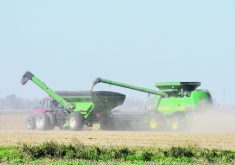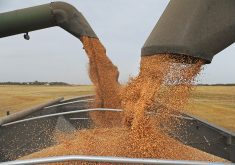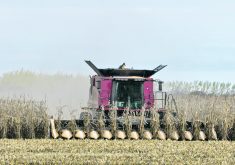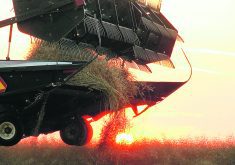Saskatchewan
Crops are podding and filling, although cool, wet weather is delaying development.
Rain in early August slowed haying progress and reduced quality. Livestock producers, however, have most hay cut with most rated good to excellent.
Across the province, topsoil moisture on cropland is mostly adequate and pasture conditions are good.
South
Rain and cool weather slowed crop development in early August.
Most crops are in the podding and filling stages, while some later seeded crops are still flowering.
Read Also

Research looks to control flea beetles with RNAi
A Vancouver agri-tech company wants to give canola growers another weapon in the never-ending battle against flea beetles.
Some producers in the Swift Current, Stewart Valley and Gull Lake areas have started harvesting with the desiccation of peas and lentils, while other areas remain as many as two weeks behind normal development.
In the southeast, there are issues with surplus moisture on some fields. Conditions were better in the southwest.
Most hay crops are rated as good.
There are reports of hail damage in the Frobisher, Glenavon, Wilcox and Vanguard areas. The most severe damage is reported in the Bracken and Orkney areas.
Damage from grasshoppers and bertha armyworms has also been reported in the southeast.
Central
Most crops are podding and filling, although many fields are two weeks behind normal compared to recent years.
Rain continued in early August, with the Langenburg region receiving 24 millimetres and the Landis area 37 mm.
Some pulses are already being desiccated in the Perdue, Major and Marengo areas.
The west-central region is furthest ahead in haying operations. Conditions across the region are good to excellent and quality is largely rated as good.
Rains have helped some producers in dry regions and there is little surplus topsoil moisture across the region.
North
Crop conditions are positive, although development remains as many as two weeks behind normal in some areas and could use warmer weather.
In the northeast, early seeded ropes have started to turn and crops are podding and filling.
Crops in the northeast continue to report the most surplus moisture and have benefited from drier weather in early August. In the northwest, dry conditions are reported in some areas.
Hay quality in the region is largely rated as good.
Grasshopper damage has been reported in the Barthel, Meadow Lake, Dorintosh and Pierceland areas. There is evidence of Swede midge damage in canola fields in northeastern Saskatchewan.
Cabbage seedpod weevil has been reported in canola in the North Battleford, but not at levels above the economic threshold, which would make spraying worthwhile.
MANITOBA
Cool temperatures and rain continue to affect crop growth. Warmer temperatures will help corn, soybean, bean and sunflower crops. The winter wheat harvest has started with reports of good quality and yields of 60 to 80 bushels per acre.
South
The area has experienced cooler temperatures and rainfall.
Cereal crops are in the soft dough stage. Fusarium headblight has been found in many fields and there is net and spot blotch in some barley fields. Many crops are lodging after recent winds and rains.
Canola is flowering and early seeded crops are coming out of bloom. Sclerotinia is appearing in the southwestern region and there are reports of armyworms in the southeast. Most flax and pea crops are done flowering.
Cereal silage is yielding average to above average.
Pastures are rated as good.
Northwest
The area has seen below average temperatures with some dropping to below 10 C overnight. Many areas are reporting 10 to 30 percent surplus moisture conditions.
Crop yield potentials are the highest at Swan River Valley, Roblin and Ste. Rose du Lac areas.
Canola, oat and barley crops are rated as excellent. With lower temperatures, corn and soybean crops are developing slowly.
Fusarium headblight and sclerotinia are evident.
Central
Cooler temperatures and rain have been common in central Manitoba. Field conditions remain good, but warmer temperatures are needed.
Cereal crops are in the late milk to dough stages. Canola crops are flowering and the early seeded fields are podded.
Growers are spraying fungicide for sclerotinia. Corn crops are tasselling and soybean and edible beans are flowering.
There is lodging in some cereal crops after rain and winds and there are reports of hail damage. Redroot pigweed and kochia are also appearing in canola and cereal crops, as are volunteer canola, soybeans, and corn.
Bertha armyworm trap counts are starting to decline.
East
Crop development is positive, although grasshoppers, green cloverworms and bertha armyworms causing concerns.
There has been spraying for diamondback larvae and there are reports of fusarium wilt or phytophthora root rot in soybeans.
Normal hay yields are being reported.
Interlake
Cool temperatures have delayed ripening in winter wheat and spring cereal crops, although the winter wheat harvest has begun in some fields with good quality but lower yields being reported. The rest will begin harvest in the next few weeks.
Wet conditions have meant a lower flowering period in canola fields. Spring cereals are turning colour and corn is tasselling.
Pasture conditions are rated as good.
ALBERTA
Crop conditions were favourable at the start of the month for much of the province.
Rain had delayed haying, but most areas received marginal amounts.
Growers are scouting for lygus bugs — and some counts are high — as well as bertha armyworms for which spraying decisions will be made in the coming weeks.
South
Crop condition ratings in the region are positive and the area has regularly received temperatures above 20 C through the first two weeks of August. Most of the area has received a small amount of rain, although Lethbridge has received over 30 mm. Hay ratings are mostly good to excellent.
Central
Crop conditions were rated at good to excellent in early August as most canola fields were podding and cereal crops approached the dough stage.
The Airdrie area has received over 18 mm of rain so far in August.
Bertha armyworm counts don’t indicate intense pressure, but they are expected to be found throughout the region.
Most hay is rated as good or excellent.
North
Crop ratings in early August were slightly better in the northwest part of the province, although most across the region were rated as good or excellent.
Many areas have seen temperatures dip below 10 C in August and there have been small rains in the northwest which has affected haying operations.
Hay quality in the northwest lags behind the rest of the province, with less than half of the harvested crop rated good to excellent.
Bertha armyworm activity is being regularly reported within the region. Provincial officials regularly found the pests in fields in the Vegreville and Innisfree areas, some of which were above thresholds.
Peace
Growing conditions remain favourable in the area which has some of the better crop ratings in the province.
The area has received some rain in August with Grande Prairie receiving over 11 mm and Peace River getting 26 mm through the first two weeks of the month.
Pest surveys in the area show low numbers of leafhoppers and diamondback moths and no presence of cabbage seedpod weevils.
Bertha armyworm activity is reported in the south Peace region. Lygus bugs are reported in many fields with one individual notingthe presence of nymphs near Beaverlodge.
















